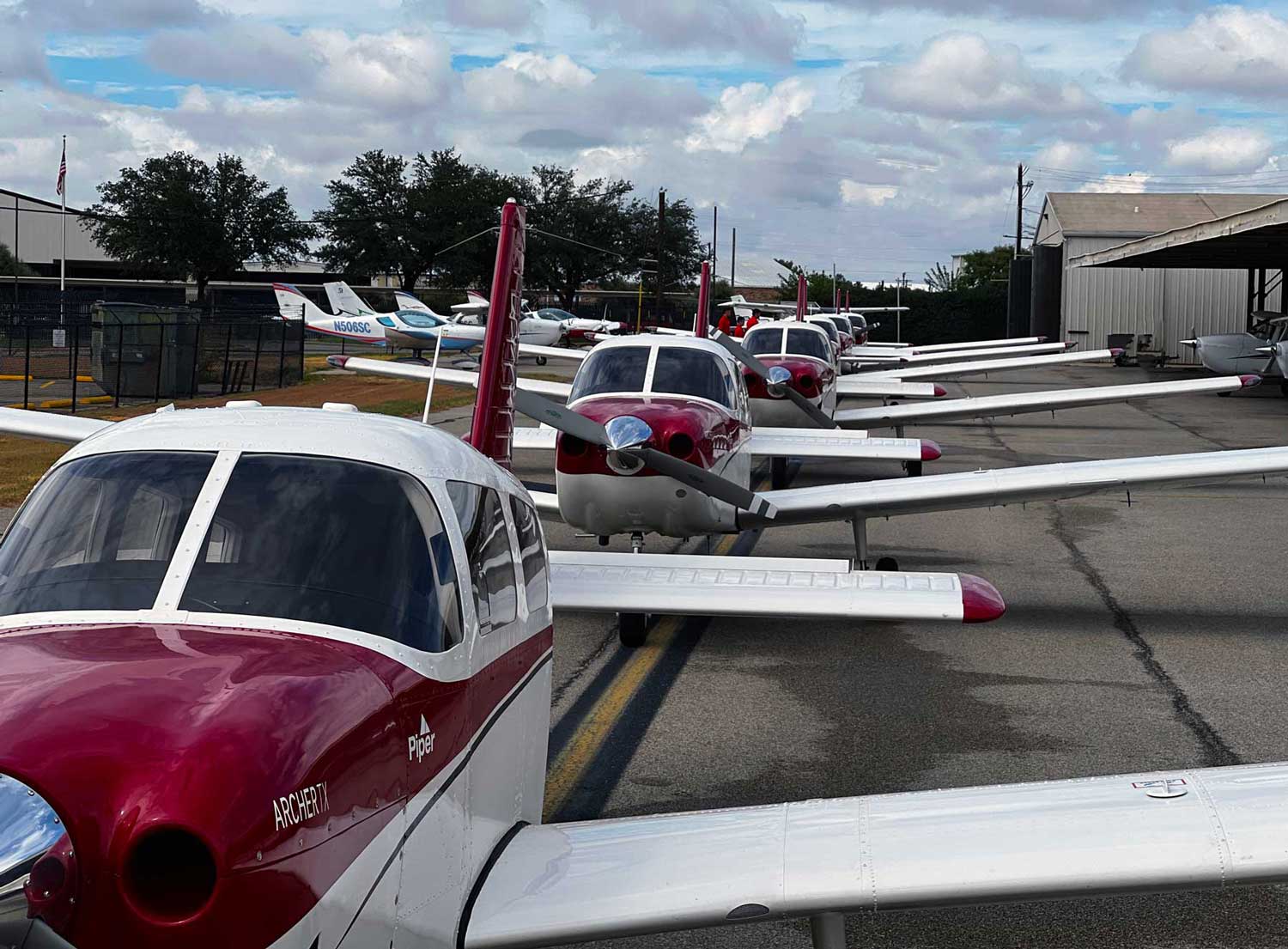
Private Pilot License
Launch a new career or pursue a long-held dream when you obtain your private pilot license at Thrust.
What is a Private Pilot Certificate?
A Private Pilot License (PPL) is an FAA-issued certificate that permits an individual to fly aircraft for personal, recreational, or charitable purposes. The license allows pilots to fly in clear weather conditions, carry passengers, fly at night, and operate in controlled airspace, such as Class B, C, D, and E.
The PPL acts as the foundational certification for all future aviation careers.
While a private pilot cannot fly for compensation or hire, this certificate is the mandatory first step before earning an Instrument Rating or Commercial Pilot Certificate.
Plenty of pilots very happily operate as private pilots, and never want or need a commercial license.
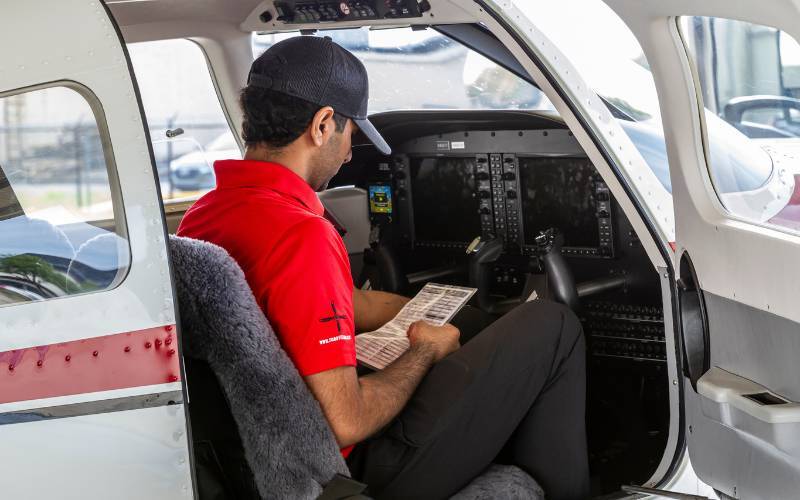
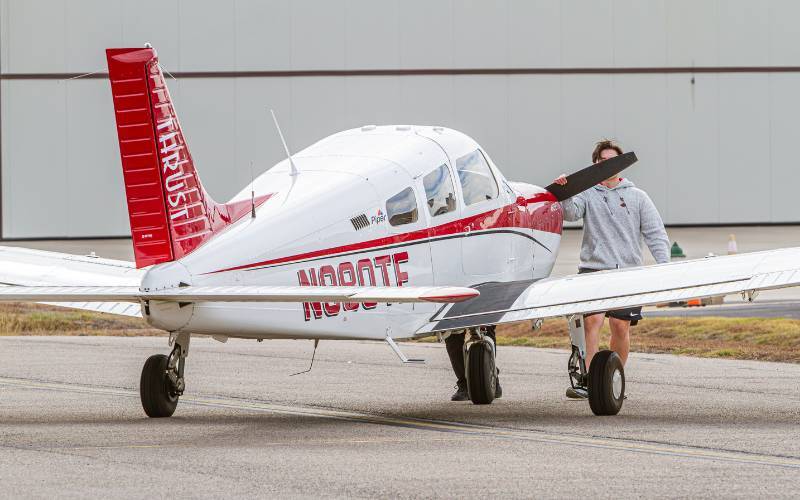
Do You Want to Become a Professional Pilot?
If your ultimate goal is to become a professional pilot the private pilot certificate is the first step in your journey.
However, you’ll need several other certificates and ratings before getting the job as a commercial pilot.
Our Zero Time to Airline program is designed to launch your professional pilot career in as little as 9 months. Click the button below to learn more about this fast-paced program.
Steps to Become a Private Pilot
Step 1: Take a Discovery Flight
A discovery flight is an introductory lesson where a Certified Flight Instructor (CFI) takes you up in a training aircraft, such as a Piper Archer. This flight allows you to experience piloting firsthand and determine if you’re comfortable in a small aircraft environment.
You also need to select a school to do your training. Often, a discover flight is a good opportunity to see the schools aircraft and get a feel if it is the right school for you.
When choosing your flight school be sure to ask lots of questions and if possible talk to current students.
Step 2: Get your FAA Medical Certificate
Student pilots must obtain a medical certificate from an Aviation Medical Examiner (AME) before flying solo. A Third-Class Medical is sufficient for hobbyists, but students pursuing a professional career should opt for a First-Class Medical to ensure they meet airline standards.
Many flight schools like ours require you to obtain a medical certificate before you can start a professional pilot program.
The flight school can recommend an AME for your aviation medical.
Step 3: Pass the FAA Written Exam
The FAA Private Pilot written exam consists of 60 multiple-choice questions covering topics like weather theory, navigation, and regulations. Students must score 70% or higher to pass. Most pilots study for this exam using an online ground school while simultaneously taking flight lessons.
Take an online private pilot ground school to prepare for the written exam.
Once you’re scoring well on your practice tests you can go to a testing center and take your private pilot written exam. Most people start their flight training while also studying for the written exam.
Step 4: Complete Flight Training and First Solo
Flight training is a mix of dual instruction (with an instructor) and solo flight. The first major milestone is the “First Solo,” where the student takes off, enters the traffic pattern, and lands the aircraft alone.
Required flight experience includes:
- Night Flight: 3 hours of training after sunset.
- Dual Instruction: 20 hours minimum.
- Solo Flight: 10 hours minimum.
- Cross-Country Flight: Navigation to airports over 50 miles away.
Step 5: Pass the Private Pilot Checkride
The final step is the Practical Test, commonly known as the “checkride.” This exam is conducted by a Designated Pilot Examiner (DPE) and consists of:
- Oral Exam: A verbal test on aviation knowledge.
- Flight Test: A demonstration of piloting skills and maneuvers.
After passing both sections, the examiner issues a temporary Private Pilot Certificate immediately. You’re officially a private pilot.

How Long Does it Take to Get Your Private Pilot License?
Most students typically take 4 to 6 months to earn their Private Pilot License when training 2 to 3 times per week. This timeline allows for consistent progression in flight skills and ground knowledge.
Students in an accelerated private pilot program can complete the training in as little as 3 weeks by flying twice a day on a full-time schedule.
These timelines depend heavily on weather conditions, aircraft availability, and student aptitude.
How Much Does it Cost to Get Your Private Pilot License?
The final cost of your private pilot will vary based on the number of flight hours you need and the number of ground hours you need.
This calculator can give you an estimate of how much it will cost to complete your private pilot. But keep in mind that this is just an estimate and the final amount will vary.
Is a Pilots License Worth It?
All pilot licenses are expensive, so you may be wondering what use the private certificate would have for you.
If you’re comparing it with the less expensive and less time-consuming sport pilot license, the private license offers you more privileges. It allows you to fly bigger, faster planes on longer trips away from home. Plus, it allows you to fly at night, or internationally.
If you’re looking to make a career as a pilot, you’ll need to make the ppl license your first step. You’ll then have to earn your instrument rating and then your commercial pilot certificate.
If you just want to go flying to have some fun, then it’s a great way to do that too.
The pilot certificate itself never expires, but you must keep it current.
What Does Private Pilot Training Look Like?
Private pilot training is done one-on-one with a flight instructor. You’ll meet with your instructor for both ground training and in flight training.
You typically meet with your instructor for a few minutes to review your homework and see if you’re ready for the flight.
During the flight, you’ll practice maneuvers or scenarios that help you understand how to better fly the plane.
Sometimes, you work on a particular skill like short field landings, steep turns, or touch and goes. Other times, you work on an entire set of skills, like navigating to a new airport.
Once the flight is over, you park the plane and debrief with your instructor.
You review your performance and discuss the things that went well—and the things that went not-so-well. From this, you put together a plan for next time.
Most flight lessons are done in two to three-hour flight blocks, but you can customize your training any way you like.
This one-on-one instructor time is often combined with a private pilot ground school course in a classroom, where you learn the book knowledge you need to pass the written exam.
What Can You Do With a Private Pilot License?
A Private Pilot License grants significantly more privileges than a Sport Pilot or Recreational Pilot certificate. Private pilots can:
- Fly any single-engine aircraft (with appropriate endorsements).
- Carry multiple passengers.
- Fly at night.
- Fly internationally.
- Operate in Class B, C, D, E, and G airspace.
- Fly for charitable events.
Restrictions: Private pilots cannot act as pilot-in-command for compensation or hire. To get paid to fly, a pilot must upgrade to a Commercial Pilot License.
Private Pilot Privileges & Limitations:
- Must hold BasicMed or a valid FAA Medical Certificate
- May operate as pilot in command of any qualified aircraft
- May fly solo or carry multiple passengers and share expenses (fuel, oil, airport expenses, and aircraft rental)
- Fly in Class B, C, D, E, and G airspace. Class A airspace requires appropriate training (view guide on airspace classes).
- Must fly in day or night visual conditions unless you also hold an instrument rating
- May fly above 10,000 ft. and at night
- May carry more than one passenger
- May fly faster than 120 knots
- May operate aircraft with retractable landing gear (with a complex endorsement)
- May not carry a passenger or property for hire or another form of compensation
- May fly outside the United States in US-registered aircraft

What are the Requirements for a Private Pilot License?
The Federal Aviation Administration (FAA) sets specific eligibility requirements for PPL applicants under FAR Part 61. To qualify, an applicant must:
- Be at least 17 years old to take the practical flight test (checkride).
- Be able to read, speak, write, and understand English.
- Hold a valid Student Pilot Certificate (or Sport Pilot Certificate).
- Hold at least a Third-Class Medical Certificate (or BasicMed).
- Pass the FAA Written Knowledge Exam with a score of 70% or higher.
- Log a minimum of 40 hours of flight time (35 hours for Part 141 schools).
- Pass the Private Pilot Practical Exam (Checkride).
Common Questions About a Private Pilot License
What Tests Do you Have to Pass to Get your Pilot License?
In total, you must pass three FAA exams to get your private pilot license, though two of those are combined into one event.
Written Exam
The first exam you must pass is commonly called the written exam, but the FAA regulations refer to it as the “aeronautical knowledge exam.” This is where all your ground school knowledge and classes pay off. You must get 70 percent or more of the questions correct.
The test is a multiple-choice exam with 60 questions, and you are given 150 minutes to take the test.
The written exam is given at FAA-designated proctored testing centers. You can find them listed on the FAA’s website. You’ll also find sample exams and information about the tests there. Taking the time to effectively prepare for your written exams is key to passing on the first attempt.
To take the knowledge exam, you must have the endorsement of the flight or ground instructor who prepared you for the exam. After the exam is over, you need to sit down with your instructor to review the knowledge areas you missed.
You’ll likely be asked about them later on.
The written exam results are good for 24 months. So you must take your check ride to get your license within two years, or else you’ll have to repeat the written exam.
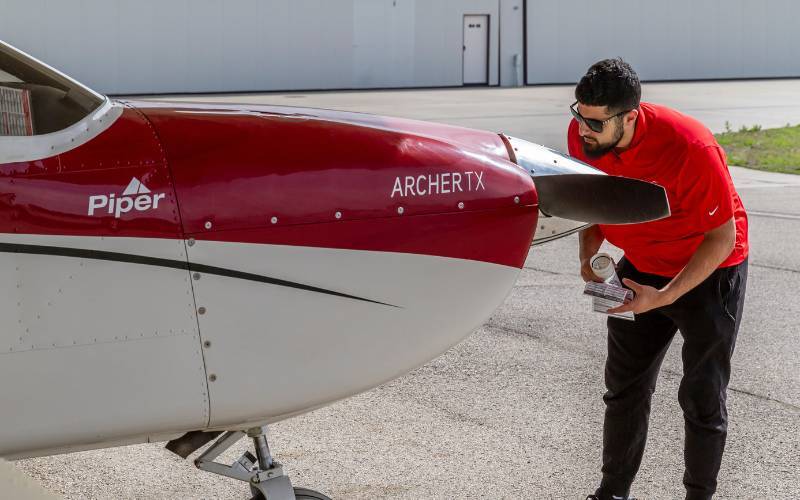
Practical Exam or Checkride
Once you’ve completed your training and your flight instructor has found that you’re ready for the check ride, they will endorse your logbook and call an examiner. The “checkride” is known in FAA circles as the practical pilot exam, and it consists of two parts.
First, you must pass an oral examination, then you move on to the airplane and show them how well you can fly.
Launch Your Pilot Career Now
Ready to start your career as an Airline Pilot? Give us a call or fill out our contact form and we’ll help you decide if our Zero Time to Airline program is right for you.
FAA employees give some FAA practical exams, but this is rare. More often than not, check rides are given by DPEs, or Designated Pilot Examiners. These are individuals from the aviation community with decades of flying experience who have earned the privilege to give check rides.
The items you’re tested on are outlined thoroughly in the Airman Certification Standards (ACS).
This document is used by your flight instructor to get you ready and your examiner on check ride day. It lays out the knowledge you need to have, the maneuvers you need to perform, and the completion standards.
There are no surprises on check ride day since everyone is using the same book.
What Are the Restrictions on a Private Pilot?
The private pilot certificate has many privileges for those who have earned one. There are no limits on where or when they can fly.
In essence, they can hop in a plane and depart on a trip across the country with no further training. They can operate at any public airport, regardless of size, and in almost every type of airspace.
But there are some significant limitations and restrictions to understand.
The first restrictions involve the word “private.” Private pilots fly for themselves; they are not professional pilots, and they cannot be paid for their flying or to take people flying.
Secondly, private pilots are limited to flying in VFR (visual flight rules) conditions, which means they can only fly in good weather. They cannot go inside of clouds, and if the visibility is low, they must stay on the ground.
VFR flying requires being able to see outside, to see visual references and landmarks. If you want to fly in low visibility, you need to get an instrument rating.
How to Get a Private Pilot License
Now that you’ve learned all the details about the ppl, you’re probably asking yourself how to get a pilot license. There are two aspects to ppl training, ground school and flight training.
Ground School
There are two distinct parts to pilot training. Most students and many flight instructors conduct these two items separately, but they are more connected than you might think.
The first part of training is commonly called ground school. This is where you get the book knowledge.
Many students have little experience in aviation before they set out to get their license. That means everything is new.
The exact knowledge areas that you learn about in ground school are listed in FAR Part 61. These are the areas that the FAA will test you on during the written exam.
- The Federal Aviation Regulations that relate to private pilots
- Accident reporting requirements
- FAA publications like the Aeronautical Information Manual and advisory circulars
- Charts, and navigation using pilotage, dead reckoning, and navigation systems
- Radio communications
- Weather theory and reports and forecasts
- Safe operating procedures
- Takeoff and climb performance
- Weight and balance computations
- Aerodynamics, engines, and systems
- Stalls, spins, and recovery techniques
- Aeronautical decision making
- Preflight actions to take
Some students complete ground school and the written exam before they even begin flying, while others fly while also taking ground school.
If you’re interested in flying but want to learn more, just taking the ground school class is a great way to get an introduction and learn a lot about aviation.
We recommend signing up for one of these online ground schools.
It’s important to note that all of the knowledge areas are important to your flying.
The bookwork you learn for your pilot license is valuable, and you’ll use the information again. You’ll build on this knowledge base as you fly, and you will need to know things from ground school to pass your check ride.
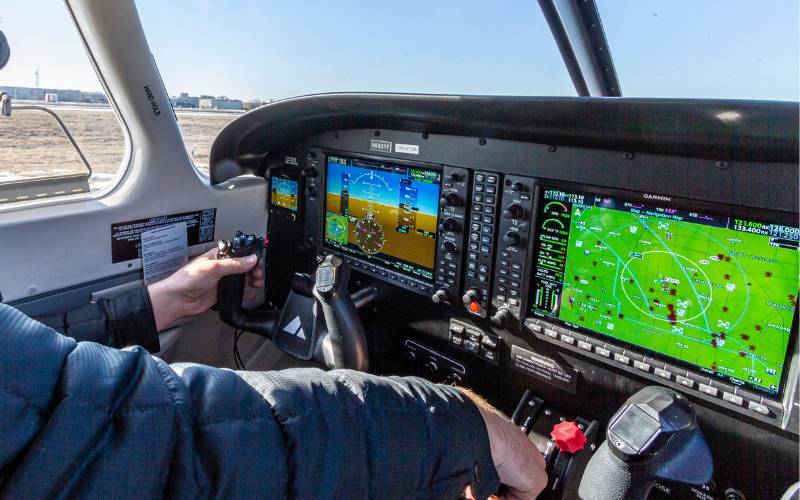
Private Pilot Flight Training
The flight training portion of your pilot license course is completely individualized. You train one-on-one with your flight instructor.
At some schools, you might fly with any flight instructor, but in most places, you work with only one primary person.
FAR Part 61 lays out the flight proficiency requirements you need to meet for getting your private certificate in a single-engine airplane.
- Preflight preparation and procedures
- Airport operations
- Takeoffs, landings, and go-arounds
- Performance and Ground reference maneuvers
- Navigation
- Slow flight and stalls
- Basic instrument maneuvers
- Emergency operations
- Night operations
- Postflight procedures
As was the case with the ground school requirements, this list only provides a very basic glimpse at everything you must learn. These are the chapter titles.
Each one of these headings represents numerous maneuvers or tasks you need to know how to perform.
Flight training is laid out in a detailed curriculum that you follow with your flight instructor’s guidance. You begin by learning the basics of operating an airplane.
As you get better, you build on your knowledge until you can conduct an entire flight with little or no help from your instructor. Once you’ve convinced your instructor that you can do it on your own, they let you take the plane up alone for some solo flying.
After you’ve soloed, you begin learning more about navigation and flying cross countries.
For the purposes of flight training, a “cross-country flight” is one to an airport more than 50 miles away. You conduct several of these longer flights with your instructor, and when they feel you’ve gotten the hang of it, they let you do a few alone.
As you follow your training curriculum, you are meeting other regulatory requirements.
The FARs lay out the specific number of flight training, solo, cross-country, solo cross-country, and night flying hours you must complete to be eligible for the license.
The last phase of your training is getting ready for the check ride. At this point, you’ve learned about all of the flight proficiency areas, and you have experience in them all.
On check ride day, nothing is new. You will have practiced everything with your flight instructor several times, so the check ride is a piece of cake.
